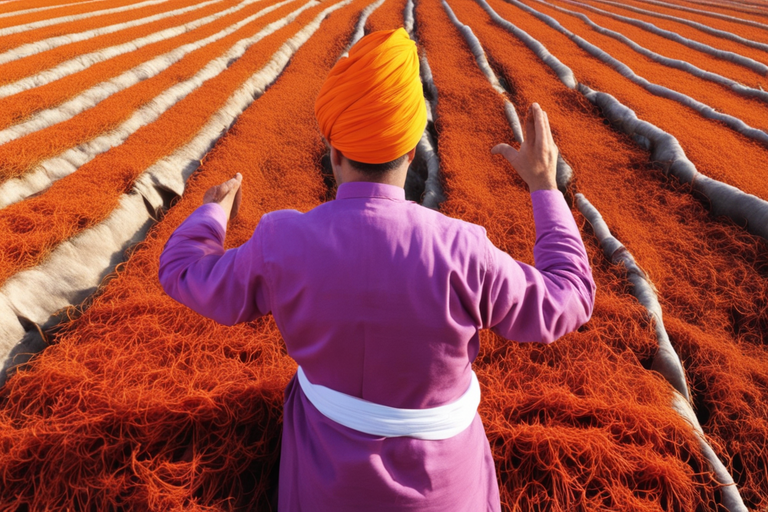
Explore the Art and Science of Saffron Farming
Saffron, known as the “golden spice,” has a long history of thousands of years. It’s famous for its bright colour, special taste, and many health advantages. Saffron is important in cooking and medicine all around the world. However, Raising saffron is hard since it requires much effort and time. This article explores saffron farming, discussing its origins, cultivation process, economic importance, and sustainable methods for its future growth.
Historical Background of Saffron
Saffron comes from a flower called Crocus sativus. It has a long history, starting from Greece and ancient Egypt. People valued it for cooking, medicine, dyeing things, and religious ceremonies. It became famous and travelled to places like Persia (now Iran), where trade became important in their way of life and economy.
Cultivation Process of Saffron
- Choosing the Right Location: Saffron cultivation requires a specific climate with well-defined seasons. The plants thrive in regions with cold winters, hot and dry summers, and mild autumns. This makes countries like Iran, India, Spain, and Greece prime locations for saffron farming.
- Getting the Soil Ready: Saffron, a plant that thrives in sandy soil and requires efficient water drainage, benefits from thorough soil preparation involving digging, mixing, and applying appropriate plant food. The process can be enhanced with equipment like the John Deere 5050D, which aids soil cultivation and preparation for optimal saffron cultivation conditions.
- Putting in the Bulbs: Saffron is grown using bulbs called corms. Planting usually happens in late spring or early summer. The corms are put into the soil, about 10-15 cm deep.
- Caring for the Crop: Saffron requires careful attention throughout its growing season. Adequate irrigation is crucial, but waterlogging should be avoided. Weeding and protection from pests and diseases are essential tasks.
- Harvesting the Stigmas: The most demanding and crucial stage of saffron farming is the harvest, typically when the flowers bloom in the fall. Every flower contains three red stigmas, which are carefully picked by hand. Since it takes a lot of flowers to produce even a tiny bit of saffron, this procedure requires much hard work.
Economic Significance
Saffron is a pricey spice because it takes a lot of work to grow. People want it for cooking, making things smell nice, and old-style healing. It’s a big deal for countries that make it because many folks, especially in the countryside, get jobs.
Sustainable Practices in Saffron Farming
As with any agricultural practice, sustainability is a growing concern in saffron farming. Here are some approaches that farmers and researchers are adopting to ensure the longevity of saffron cultivation:
- Diversification: To reduce the risk associated with saffron monoculture, farmers are exploring cultivating other crops alongside saffron. This helps maintain soil health and mitigate the environmental impact.
- Water Management: Saffron is grown in dry places with limited water. Using smart ways to water plants, like drip irrigation, saves water and better manage water.
- Organic Farming: Many saffron farmers are changing how they farm to organic methods. They’re not using fake fertilisers or pesticides. This helps ensure the spice is good and keeps the environment safe. It also supports the farmers and people who eat the saffron healthy.
- Biodiversity Preservation: Maintaining a diverse ecosystem around saffron fields helps control pests naturally and promotes a healthy environmental balance.
Challenges in Saffron Farming
Saffron farming, while rewarding, comes with its share of challenges:
- Labor Intensity: The delicate process of hand-picking the stigmas makes saffron one of the most labour-intensive agricultural activities. The lack of mechanisation limits the scale of production.
- Climate Change: Saffron cultivation’s dependence on specific climatic conditions makes it vulnerable to the effects of climate change. Erratic weather patterns can disrupt the flowering season and affect crop yields.
- Market Price Fluctuations: The high market value of saffron can lead to price fluctuations, impacting farmers’ income and the stability of saffron-dependent economies.
Conclusion
Saffron farming is a skill that has improved over hundreds of years, blending old ways, science, and careful attention. From where it started in history to how it matters for the economy and eco-friendly methods today, saffron shows how farmers can adjust to new times with tools like the John Deere 5405 tractor.
As mechanisation advanced, innovations have played a crucial role in enhancing efficiency and productivity in saffron cultivation. This harmonious integration of tradition and technology ensures that saffron will continue to hold significance for diverse cultures and cuisines as more people seek real, high-quality spices.
